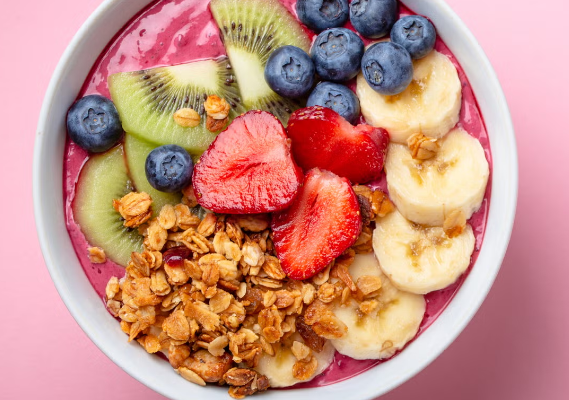Are Açai Berries Actually Healthy? Nutritionists Explain
For such little fruit, they are actually packed with health benefits.
If you’ve been looking for new healthy foods to add to your menu, açai (pronounced ah-sigh-EE) might be one to try. Its bright purple hue and tart taste make it a popular base for fruit smoothie bowls. While you can certainly buy ready-made bowls in restaurants, açai is pretty easy to make at home and it’s so versatile you can add whatever toppings strike your fancy. Just use the strategies below to ensure you’re making the most of açai’s health benefits and not overdoing it with sugar.
What is açai?
Found on açai palm trees in South American rainforests, açai berries are a lot like grapes. The seed takes up about 80% of the berry, but the flesh and skin contain plenty of vitamins and other nutrients.
“Unsweetened acai is tart and earthy, which is why it’s often manufactured with sweeteners,” says Cassetty. “I saw some pouches with 12 grams of added sugar, which is equal to 3 teaspoons — half of the 6 teaspoons daily limit for women. But you can make unsweetened versions sweeter by adding half a banana or another sweet fruit instead of added sugars.”
Because açai berries can spoil within a day, the best ways to buy them are frozen (like smoothie packs) or in powdered form.
Is açai healthy?
“All fruits and vegetables are healthy additions to your diet unless you’re allergic or don’t tolerate certain ones,” says Samantha Cassetty, M.S., R.D., nutrition and wellness expert, founder of Sam’s Plate and co-author of Sugar Shock. “About 90% of people aren’t meeting their needs for these foods, so açai can be a great option. However, most people consume açai in bowls or smoothies, and depending on how they’re made, they can be sugar traps.
Açai bowls can also have more than 800 calories and more than 150 grams of carbohydrates, which may be too much for some people.” To avoid excess sugar when preparing it at home, opt for unsweetened açai powder or frozen açai. Then, you can reap the benefits of the many nutrients in açai like these:
- Antioxidants: Like other berries, açaí are packed with antioxidants that can help build up your immune system and protect your cells against damage from free radicals. “Acai contains numerous beneficial bioactive substances that have antioxidant and anti-inflammatory properties,” says Cassetty. “Choosing antioxidant-rich foods that may potentially lower inflammation is a long-term strategy for staying healthy.”
- Fiber: Because it’s full of fiber, açaí may not only help make your trips to the bathroom more regular, but also help keep you full and your blood sugar steady.
- Heart-healthy fats: Açai is a great source of omega-3 fatty acids, which can lower your risk of coronary heart disease and improve your cholesterol.
Health benefits
While açai is nicknamed “purple gold,” it’s most beneficial when it’s part of a balanced diet. “Although lots of people eat these berries — amongst other foods — for their ‘magical powers,’ you’re not going to find magic in one food,” says Bonnie Taub-Dix, RDN, author of Read It Before You Eat It. “The magic comes from a diet that contains a variety of foods that work in concert with each other.” Here are a few of the health conditions that a well-rounded diet may support when açai is included:
Side effects
Açai is generally safe to consume. However, it may throw off MRI results so talk to your doctor before eating it if you have an MRI scheduled soon, advises the National Institutes of Health. There’s also not enough evidence to say it’s okay to eat when pregnant or breastfeeding. Similarly. you should consult with your physician before taking any supplements, including açai, to avoid potential drug interactions.
How to make an açai bowl
In a blender, Cassetty recommends mixing ¼ cup unsweetened milk of your choice, ⅓ cup Greek yogurt, ½ to 1 banana and 1 unsweetened frozen açai packet. (You can add more milk if you prefer a thinner texture.) “Since an açai bowl uses plenty of fruit, I would skip the fruit toppings or add them sparingly,” she says. “Instead, round out your bowl with other food groups, such as low-sugar granola, high-fiber, low-sugar cereal, unsweetened, toasted coconut, a drizzle of nut or seed butter and/or nuts or seeds (such as chia, hemp or flax seeds). If you want more protein in your bowl, you can always add more yogurt on top.”
The bottom line
Açai can be a fun and tasty way to add fiber and other healthy nutrients to your diet. The key is to make açai bowls at home with unsweetened açai and top them with yogurt, nuts and other low-sugar foods.




